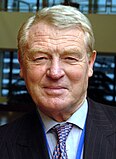| |||||||||||||||||||||||||||||||||
All 36 metropolitan boroughs, all 296 English districts and all 37 Welsh districts | |||||||||||||||||||||||||||||||||
|---|---|---|---|---|---|---|---|---|---|---|---|---|---|---|---|---|---|---|---|---|---|---|---|---|---|---|---|---|---|---|---|---|---|
| |||||||||||||||||||||||||||||||||
The 1991 United Kingdom local elections were held on Thursday 2 May 1991.[2][3] The results were a setback for the governing Conservative Party, who were left with their lowest number of councillors since 1973, though their popular vote was an improvement from the 1990 local elections.
This was the first electoral test for Prime Minister and Conservative leader John Major, who had taken the helm from Margaret Thatcher in November 1990.
Labour and the Liberal Democrats both benefited from the Conservative losses.
The main opposition Labour Party gained 584 seats, bringing their number of councillors to 9,504, their highest since 1975. Their projected share of the vote was 38%, a decline of 6% from the previous year. They overtook the Conservatives in number of councillors and would remain in that position until 2003.
The governing Conservative Party lost 1,035 seats, leaving them with 7,985 councillors. Their share of the vote was projected to be 35%, an increase of 2% from the previous year.
The Liberal Democrats gained 407 seats and had 3,672 councillors after the elections, a record number and a sign of their improving popularity after a series of disastrous performances in local and European elections after their formation in March 1988. Their projected share of the vote was 22%, up from 17% in 1990.[4]
Despite the Conservatives' heavy losses, the party would go on to win the 1992 general election 11 months later.
- ^ "Local Election 1991 - Thursday, 2nd May, 1991". Stockport Metropolitan Borough Council. Archived from the original on 21 May 2022. Retrieved 21 May 2022.
- ^ Rallings, Colin; Thrasher, Michael. Local Elections Handbook 1991 (PDF). Local Government Chronicle Elections Centre. Retrieved 3 May 2016.
- ^ "Council compositions". The Elections Centre. Retrieved 3 May 2016.
- ^ "The 1992 General Election - Liberal Democrats". BBC News. Retrieved 3 May 2016.


